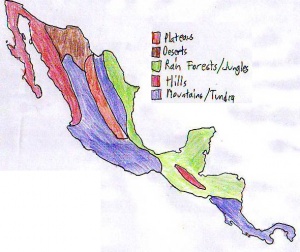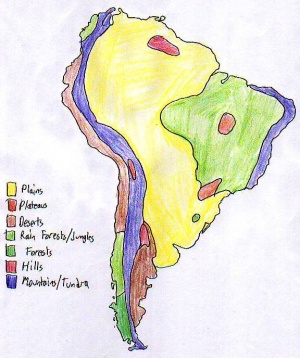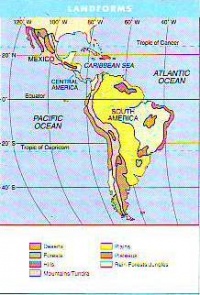Difference between revisions of "World Cultures Portfolio/Latin America"
From ThePlaz.com
(did a lot on 1st draft - computer) |
(finish 1st draft) |
||
| Line 16: | Line 16: | ||
The land bridge of Central American can also explain a lot. Thousands of years before the Europeans "discovered" South America, native peoples must have wondered across that thin strip of land to find the vast continent of South Africa. These people must have also crossed over from Russia centuries before that. That land bridge, however, no longer stands. | The land bridge of Central American can also explain a lot. Thousands of years before the Europeans "discovered" South America, native peoples must have wondered across that thin strip of land to find the vast continent of South Africa. These people must have also crossed over from Russia centuries before that. That land bridge, however, no longer stands. | ||
| − | In the north of Latin America lies Mexico. Below the Rio Grande the deserts of the American west continue. Although the map doesn't show it, the Baja Peninsula can also be considered a desert. The Sierra | + | In the north of Latin America lies Mexico. Below the Rio Grande the deserts of the American west continue. Although the map doesn't show it, the Baja Peninsula can also be considered a desert. The Sierra Madere mountains and Central Plateau make this not a good spot for agriculture. |
| − | Moving down into Central America, one finds rain forests. Rain forests grow in the hot, humid lowlands near the equator. Mountain ranges and hills sometimes intersperse themselves throughout the desert, but for the most part, the rain forests make up the lowlands. The land between the mountains and ocean sometimes does not extend far enough, and thus coastal plains may not be shown on map. | + | Moving down into Central America, one finds rain forests. Rain forests grow in the hot, humid lowlands near the equator. Mountain ranges and hills sometimes intersperse themselves throughout the desert, but for the most part, the rain forests make up the lowlands. The land between the mountains and ocean sometimes does not extend far enough, and thus coastal plains (or deserts) may not be shown on map. |
| − | + | The west side of South America follows a similar pattern. Deserts lie sandwiched between the ocean and the high Andes mountains (which are the second highest on earth (Blue Textbook 442). Near the southern tip of South American, however, the sandwiched area turns to forests because of the precipitation blowing up from Antarctica (Blue Textbook 445). | |
| − | + | However, for the most part, the eastern half of South America, of which Brazil comprises most of, plains on jungles lie. The Amazon Basin takes up 40% of Latin America and comprises of mostly rain forests, however the textbook map lists it as plains (Blue Textbook 442). This area, from the snowy Andes mountain in Peru, sources the great Amazon River. Perhaps jungles surround only the lower section of the river. Ships can travel up to 2,300 miles into the Amazon, opening up an essential shipping route. Lumbar, livestock, and minerals make up the primary exports of the region (Blue Textbook 443). These resources then get traded for other goods in the world marketplace. | |
| − | - | + | At the every eastern side of South America, the Brazilian Highlands separate the Amazon Basin from the Atlantic Ocean (Red book map). Because these mountains do not extend as high, the rainfall effect does not happen as much here. |
| + | |||
| + | Below the Brazilian Highlands, but still to the east of the great mountains, lies Argentina. Deserts comprise its lower half, but plains extend above it and into the Amazon Basin. Closer to the Andes and Chile, lie the pampas grassy plains (Blue Textbook 442). Here wheat farmers and cattle ranchers make up one of the most productive farming regions of Latin America (Blue Textbook 442). | ||
| + | |||
| + | These geographical dividers separate Latin America into smaller sub-regions. Not until the Europeans arrived was the region even thought of as a whole. The people, it seems, did not go exploring far to discover and trade with other cultures. This contributed to regionalism, separating the different cultures of Latin America (Blue Textbook 442). This means that they developed separately unlike other, smaller regions we studied like Japan and Korea. In addition, the Americas existed quite far away for the trade around the Mediterranean Sea, the cradle of modern civilization. Only recently did the Europeans come over, and when they did, they ever exploitative of the people and resources they found. Even the East was not this cut off (unless they decided to cut off global trade) | ||
| + | |||
| + | But whatever landform exists in a certain part of Latin America, one can be sure that it had some kind of effect on the peoples of Mexico, the Caribbean, Central, and South America. Centuries ago, Spanish and Portuguese settlers, the Latin people, found the vast expanses of the area and called it their own. They too affected the people, but, they too were thwarted by geography. | ||
==Sources== | ==Sources== | ||
| + | *Red book map | ||
*Blue textbook | *Blue textbook | ||
*http://encarta.msn.com/encnet/features/MapCenter/MapPrintPreview.aspx?lat=19.4330220000885&long=-99.1399362555466&alt=4&mapsize=Medium&mapstyle=climate&mapstyleselectedindex=8&selectedent=10101474&entityname=Latin%20American%20Tower%20%5BTorre%20Latinoamericana%5D%20(building),%20Mexico%20City,%20Mexico | *http://encarta.msn.com/encnet/features/MapCenter/MapPrintPreview.aspx?lat=19.4330220000885&long=-99.1399362555466&alt=4&mapsize=Medium&mapstyle=climate&mapstyleselectedindex=8&selectedent=10101474&entityname=Latin%20American%20Tower%20%5BTorre%20Latinoamericana%5D%20(building),%20Mexico%20City,%20Mexico | ||
Revision as of 02:06, 18 January 2007
World Cultures Latin American Report about Landforms
Intro/Basics - Africa - Middle East - South Asia - China - Japan - Korea - Latin America
Only spent half a day on this unit World Cultures Daily Questions
Notebook
- Page 101 - Central American Map, South American Map, Geo Notes, Page 2
- Page 102 - Latin American Notes, Page 2, Page 3, Page 4, Page 5, Page 6, Page 7, Page 8, Page 9
Portfolio
- Portfolio
- Landforms Report
Africa: HDI Graph Reflections - Decolonization Report
Middle East: Population Density Report - Essay: A Peaceful Vacation
South Asia: Rainfall Report - South Asia Comparisons Graph - Postcards
China: Sphere of Influences Report - Mao Button Journal
Japan: Natural Resources Report - Japanese Violence Journal
Korea: Physical Map Report
Latin America: Landforms Report
Worldwide: T-Shirt Trade Report
Latin America stretches 5,500 long miles from the Rio Grande River to the tip of Cape Horn (Blue Textbook 441). The region receives its name from the Latin people who first "discovered" it centuries ago (Blue Textbook 441). The region stretched from tropical rain forests to icy wastelands near Antarctic (Blue Textbook 441). Latin America, a vast collection of different sub-regions, means that not just one story exists about Latin American landforms. Latin America contains Mexico, 7 nations of Central America, Puerto Rico and 13 other Caribbean nations, along with 14 nations of South America (Blue Textbook 441). Latin America covers 20% of the earth's land surface area.
Much of the geography of Latin America gets affect by the La Cordillera mountain range (Blue Textbook 441). These mountains run the entire length of Latin America and even extend into North America (Blue Textbook 441). The name might not sound familiar because the mountains have different names in different regions. The United States calls its section the Rocky Mountains. In Mexico, the Sierra Madres affect most of Mexico. The chain continues down through Central America, no doubt the force which created that land bridge. In South America, the mountains hug the western cost of the country leaving little coastal plains. The mountains, as seen before, cut of the rain clouds from crossing them. Thus the Atacama Desert exists (Blue Textbook 441). Some parts of it have not received rain in 400 years (Blue Textbook 441).
The land bridge of Central American can also explain a lot. Thousands of years before the Europeans "discovered" South America, native peoples must have wondered across that thin strip of land to find the vast continent of South Africa. These people must have also crossed over from Russia centuries before that. That land bridge, however, no longer stands.
In the north of Latin America lies Mexico. Below the Rio Grande the deserts of the American west continue. Although the map doesn't show it, the Baja Peninsula can also be considered a desert. The Sierra Madere mountains and Central Plateau make this not a good spot for agriculture.
Moving down into Central America, one finds rain forests. Rain forests grow in the hot, humid lowlands near the equator. Mountain ranges and hills sometimes intersperse themselves throughout the desert, but for the most part, the rain forests make up the lowlands. The land between the mountains and ocean sometimes does not extend far enough, and thus coastal plains (or deserts) may not be shown on map.
The west side of South America follows a similar pattern. Deserts lie sandwiched between the ocean and the high Andes mountains (which are the second highest on earth (Blue Textbook 442). Near the southern tip of South American, however, the sandwiched area turns to forests because of the precipitation blowing up from Antarctica (Blue Textbook 445).
However, for the most part, the eastern half of South America, of which Brazil comprises most of, plains on jungles lie. The Amazon Basin takes up 40% of Latin America and comprises of mostly rain forests, however the textbook map lists it as plains (Blue Textbook 442). This area, from the snowy Andes mountain in Peru, sources the great Amazon River. Perhaps jungles surround only the lower section of the river. Ships can travel up to 2,300 miles into the Amazon, opening up an essential shipping route. Lumbar, livestock, and minerals make up the primary exports of the region (Blue Textbook 443). These resources then get traded for other goods in the world marketplace.
At the every eastern side of South America, the Brazilian Highlands separate the Amazon Basin from the Atlantic Ocean (Red book map). Because these mountains do not extend as high, the rainfall effect does not happen as much here.
Below the Brazilian Highlands, but still to the east of the great mountains, lies Argentina. Deserts comprise its lower half, but plains extend above it and into the Amazon Basin. Closer to the Andes and Chile, lie the pampas grassy plains (Blue Textbook 442). Here wheat farmers and cattle ranchers make up one of the most productive farming regions of Latin America (Blue Textbook 442).
These geographical dividers separate Latin America into smaller sub-regions. Not until the Europeans arrived was the region even thought of as a whole. The people, it seems, did not go exploring far to discover and trade with other cultures. This contributed to regionalism, separating the different cultures of Latin America (Blue Textbook 442). This means that they developed separately unlike other, smaller regions we studied like Japan and Korea. In addition, the Americas existed quite far away for the trade around the Mediterranean Sea, the cradle of modern civilization. Only recently did the Europeans come over, and when they did, they ever exploitative of the people and resources they found. Even the East was not this cut off (unless they decided to cut off global trade)
But whatever landform exists in a certain part of Latin America, one can be sure that it had some kind of effect on the peoples of Mexico, the Caribbean, Central, and South America. Centuries ago, Spanish and Portuguese settlers, the Latin people, found the vast expanses of the area and called it their own. They too affected the people, but, they too were thwarted by geography.





